The iPad Air Review
by Anand Lal Shimpi on October 29, 2013 9:00 PM ESTiPhone to iPad: CPU Changes
Although the iPad Air uses the same A7 from the iPhone 5s (and M7 motion coprocessor), there are a few minor differences that do lead to better performance.
At a high level we’re still talking about two 64-bit Apple Cyclone cores with 128KB L1s (64KB I$ + 64KB D$) per core, a shared 1MB L2 cache and a 4MB L3 cache that services the entire SoC. Apple increased CPU frequency from 1.3GHz to 1.4GHz in the iPad Air, a mild increase but in line with what we’ve seen from previous iPad designs. That’s the first impact on performance - a 7.69% increase in CPU frequency.
The second impact on performance is something I only noticed while digging around under the hood of the A7. It seems like the implementation in the iPad Air can, for whatever reason, hold more instructions in flight (over 20% more) than the A7 in the iPhone 5s. It’s unclear to me whether the A7 in the iPad is configured any differently via firmware/microcode or if perhaps we’re looking at a slightly different revision of the core, but the delta was repeatable in my testing.
The third, and likely biggest change impacting the iPad Air’s implementation of the A7 is the additional thermal headroom afforded by the larger chassis. I’m not going to go into details on exactly what this next test does (unfortunately we’re going to occlude some of the low level work that we do in light of all of the benchmark cheating going on), but we’re looking at a curve of performance vs. time for a particularly power heavy mix of code. We’re running the same exact code on both the iPad Air and iPhone 5s here, the only real difference is the size of the chassis:
You can see the 5s throttles back its CPU frequency to about 1GHz after the 2 minute mark. The crazy thing is that until that point the 5s manages to run at full frequency without so much as a hiccup for two full minutes, running an incredibly power hungry task. Given that most iOS apps aren’t this power intensive for such a sustained period of time, iPhone 5s users should almost always see the A7 running at a full 1.3GHz. Pretty crazy.
The iPad Air by comparison shows much more controlled behavior. Early on in the test we see a 7.7% performance advantage, which lines up perfectly with the iPad Air’s 7.7% CPU frequency advantage. By the end of the test the iPhone 5s has throttled to 900MHz, while the iPad Air drops to around 1.2GHz. At this point the iPad Air’s performance advantage grows to almost 40%.
CPU Performance
I've gone through our standard set of cross-platform browser based benchmarks to place the iPad Air's performance in perspective. As I mentioned in our 5s review, I don't know that there are many (any?) applications on iOS 7 that can really take advantage of all the A7 has to offer. There's definitely a ton of headroom left in the design. What's particularly exciting is when the A7 ends up in n-1 or n-2 iOS devices and it becomes the minimum developer target going forward.
I won't go through all of the results here again, but it's safe to say that the iPad Air is the fastest ARM based tablet on the planet at this point.
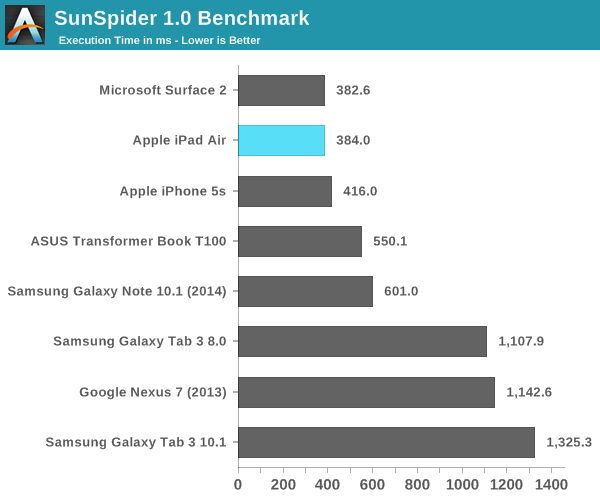
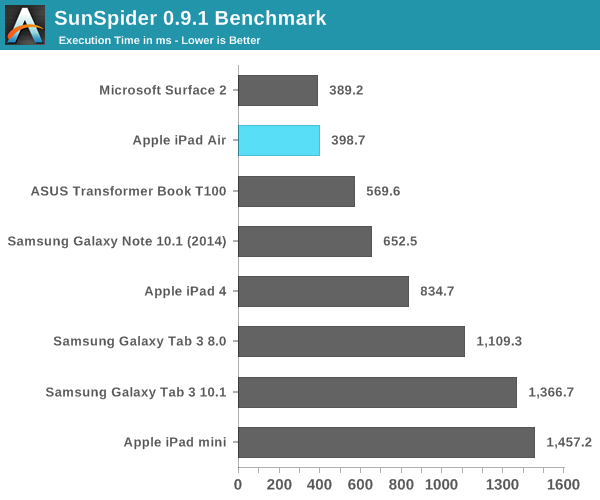
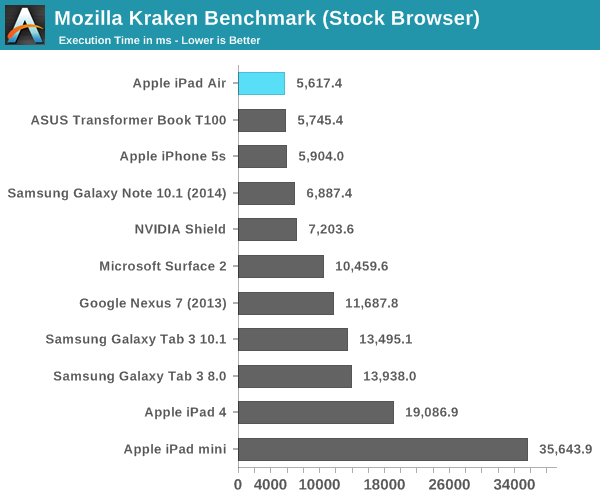
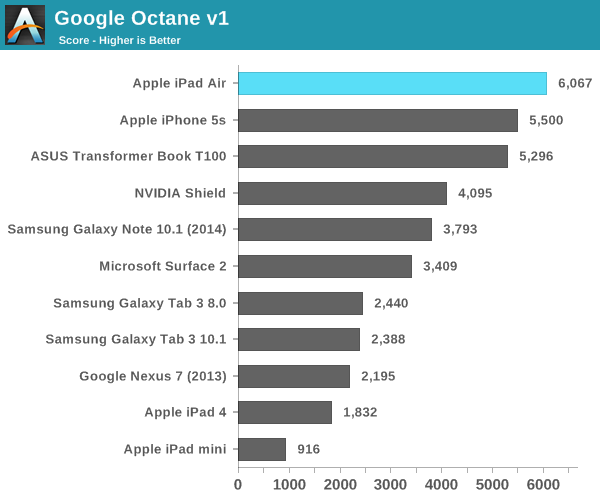
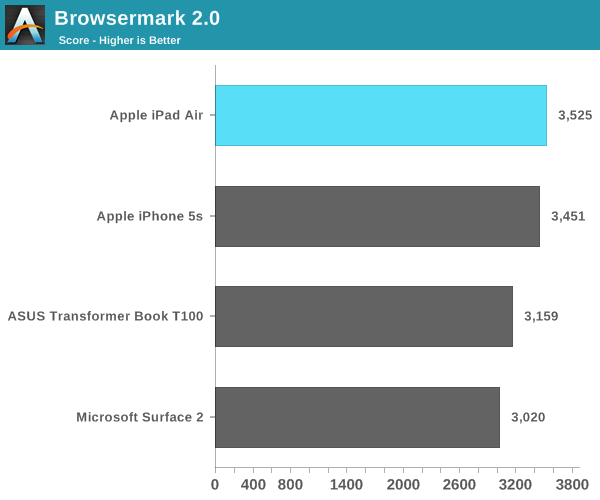

A7 Power Consumption
I’ll get to battery life in a bit, but I’ve been curious about the dynamic range of power consumption offered by Apple’s new A7 SoC. On the one hand we’re dealing with a lower power process (28nm vs. 32nm), but on the other hand Apple’s Cyclone cores can clearly draw more power given how beefy the architecture is this round. Apple frowns upon review sample dissection so I had to turn to a less scientific method of external platform level power measurement. The fidelity of the numbers here aren’t all that great but it’s better than nothing.
For the first test I measured platform power consumption during a Kraken run:
I purposely started measuring before the benchmark so I could get an idea of idle power consumption. The iPad Air consumes roughly 72% of the idle power as the iPad 4, both running at the same brightness. Here we’re not just seeing the A7’s advantages but also things like lower display power.
Focusing on the load portion of the measurement we see that both the new iPad and old iPad consume the same total power in this test. I suspect the A7 is drawing more power than the A6X, but it’s masked by a lower power display. Given how much faster the iPad Air is, Apple’s latest tablet features far lower overall task energy than the outgoing iPad 4. This is probably both the best case scenario for the iPad Air and the most likely case as well.
For kicks I wanted to see just how much power I could get the iPad Air to draw. Here I’m looking at platform power during our mini-power-virus test from above:
How’s that for dynamic range? Almost 12W running all out, but around half that in what we’d normally consider to be a stressful CPU test. I couldn’t get any actual applications/games on the iPad Air to behave like this so the results above are purely academic (for now). A quick run through GFXBench 2.7’s T-Rex HD test confirms that even pushing the GPU won’t hit these numbers. The max I saw running T-Rex offscreen was ~6W, and turning to an actual game (Infinity Blade 3) the iPad Air pulls less than 5W.


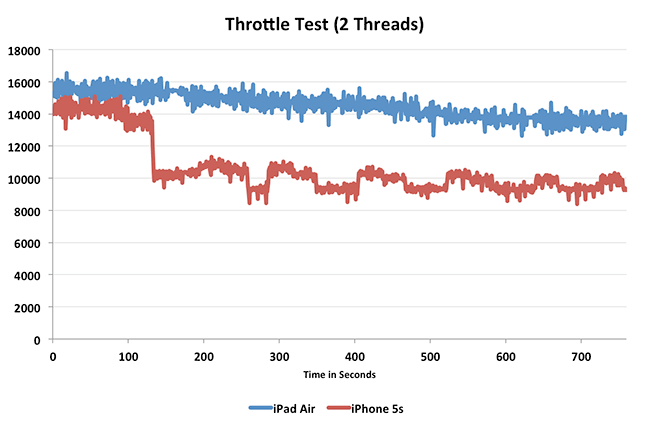
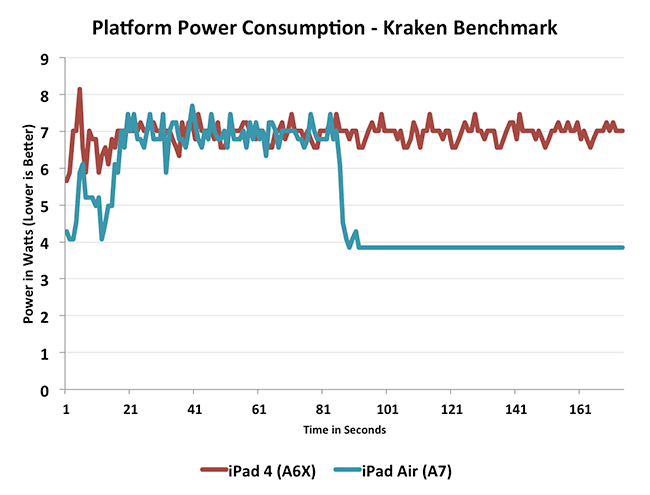
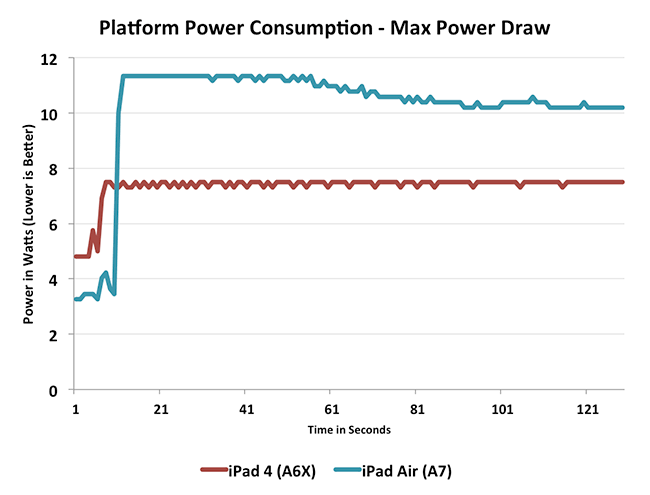








444 Comments
View All Comments
blacks329 - Tuesday, October 29, 2013 - link
The pointless dilemma caused by AnandTech reviews: Do I read it now and spoil all my other reviews, or do I save it for later after reading all the other 'reviews' but feel underwhelmed by reading them.I feel like a child wanting to have dessert, except this dessert is actually better for me than the main course, but I'm gonna have the main course anyway because of my OCD with tech reviews.
(I like reading multiple reviews for a product - even if I have no intent to purchase them)
ArthurG - Tuesday, October 29, 2013 - link
a bit OT, but more I look at the graphs, more I think SHIELD is a great piece of hardware ! Screen, GPU performance and battery life are top class. And with the last 4.3 update, its coming all together on the software side.I'm holding the trigger because I think SHIELD 2 will be the real deal with amazing Logan GPU. But the first iteration is already very tempting...
Commodus - Tuesday, October 29, 2013 - link
Definitely. There's a certain cruel irony to it leading in some tests, because many will skip over it as a matter of course -- it's not a tablet, after all.Arbee - Wednesday, October 30, 2013 - link
I have a Shield (I can't help it, I'm an early adopter) and I think it's an underrated device (although AT's Brian Klug has been pretty positive on it). Weight is a bit excessive, but it's hard to beat for mobile gaming - the controls are better than either the 3DS or Vita, even if the game selection is kind of anemic. For now I don't care though, I have GTA 3 and Vice City with real controls in my carry-on bag. That would've been science fiction 10 years ago.Khato - Tuesday, October 29, 2013 - link
Simply awesome to see the greater depth of detail regarding the A7. Many thanks for doing so as most don't seem interested in understanding why it's performing so well. Given the magnitude of the geekbench subscore performance improvements I was convinced that somehow the frequency being reported was incorrect, but instead they made it a surprisingly 'wide' core. (As in, after accounting for the difference in ISA, it may well be comparable to Intel's core line in that respect.)Of course this really brings into question how a Baytrail-T (or even Haswell-Y) based tablet compares to the iPad Air in the platform power consumption metric. (Same goes for Snapdragon 800 and Tegra 4 just because it's a useful data point to have when looking forward to these SoCs being used for applications that actually need compute power.) Given that the idle -> load delta for A7 looks to be ~3W for Kraken and ~7W for the maximum...
Which reminds me, are the power numbers you listed for T-Rex offscreen and Infinity Blade 3 total platform power consumption or the delta? Curious since if it's total that would mean that gaming uses less power than Kraken?
MrRez - Tuesday, October 29, 2013 - link
The Shield is a beast :)ltcommanderdata - Tuesday, October 29, 2013 - link
The A7 die shot is labeled with 4 DRAM interfaces. 2 large ones (presumably the main 2x32-bit memory bus) and 2 smaller ones (maybe 16-bit wide each). Any idea what the smaller ones are used for?errorr - Wednesday, October 30, 2013 - link
I would assume they are for all the other peripheral devices or what we used to call a northbridgeMykeM - Tuesday, October 29, 2013 - link
The battery time looks awfully nice. Of course, the iPad 4 is no slouch although as I'm holding it, it also makes complete sense that something so heavy should hold a battery that lasts as long.iPad Mini is never an option for me. Try running apps like Korg iMS-20 on the Mini: it's a nightmare filled with minuscule knobs and sliders. So a 1 lbs full sized iPad with better battery life and more powerful sounds mighty tempting. I'm hoping Apple would even go bigger- 12, 13 or even 15" iPad (Pro).
Arbee - Wednesday, October 30, 2013 - link
Agreed. A 13" iPad Pro would be awesome for iMS-20, among other things.Related to this, I wish Anand would get in touch with how people actually use iPads (e.g. the whole AudioBus and music creation scene). He seems stuck in the "but doing office stuff on it isn't as good as a PC" rut because that's all he uses PCs for, and it's lead him to not understand why the iPad is dominant while Android and Windows tablets struggle.